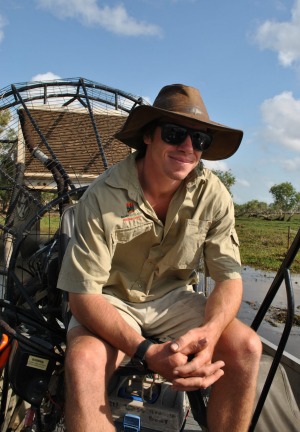Located just to the west of Kakadu National Park, Bamurru Plains offers the visitor a profusion of birds and wildlife with a unique bush lodge that exudes luxury. Video courtesy of Wild Bush Luxury
Until now, I always thought I knew the true meaning of goose-bumps. It's just before dawn in the Top End, as the sun slips above a paperbark forest treeline. Our air-boat skids across the muddy surface of a vast sodden floodplain that in the wet can extend the whole way to Arafura Sea. As we power along, having donned earmuffs to minimise the racket from machine's engine and propeller, hundreds, maybe thousands, of magpie geese take off in near unison, before us, their collective honking like Hong Kong in the middle of peak hour.
But while the Everglades-style airboat, with its Teflon underbelly designed to ease its passage along the shallow waters, may be a somewhat unwelcome visitor in these parts for the magpie geese, its true predator, the saltwater crocodile, is an ubiquitous presence, although they're not the most physically dominant creature on the floodplain.
Hulking Asian water buffalo, an introduced species of cattle dodging the airboat is rather less elegant than that of the magpie geese, or "bamurru" as they're called in the local Aboriginal language. Lumbering as they are, the buffalo are the bovine equivalent of a four-wheel drive, biologically suited and fully adapted to the sludgy conditions.
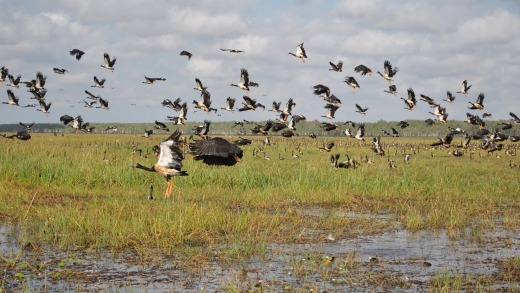
Everywhere there's a strange, low-frequency buzz emanating from the massed magpie geese as Riley, our young guide and airboat driver, cuts the engine as we watch a jabiru, also known as a black-neck stork, breakfasting on an eel.
I've never suffered from an overweening itch to twitch, but, suddenly, based on the birdlife that we're spotting – one species of which, namely cattle egrets, are hitching a ride on the back of the buffalo – I suddenly get the appeal. It's taken this visit to here at Bamurru Plains, a remote luxurious lodge-style property about three hours' drive from Darwin, to uncover my inner-twitcher.
Bamurru Plains is located on the private Swim Creek Station, a vast crocodile-infested property just 10 kilometres from Kakadu National Park, with a tiny part of it actually adjoining the World Heritage site. Our accommodation, separate to the working station, is a spacious timber-floored bungalow – one of 10 – positioned on the edge of a floodplain, now sucked dry of nearly all of its wet season water.
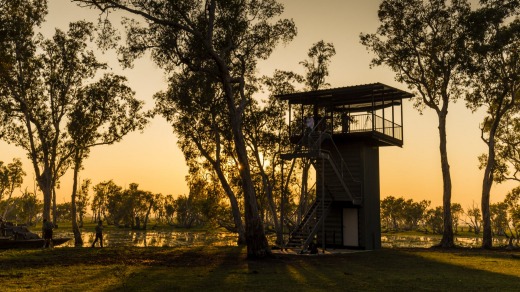
There is not a single pane of glass with our accommodation, which rather accurately bills itself as "Wild Bush Luxury", encased in an insect-proof, hessian-like screen, the colour of which gives the view outside a weird yellow-brown tinge. There's no air-conditioning but no less than six fans throughout the bungalow keep it tolerably cool by night and reasonably so by day. The main camp, through which the agile wallabies (as the local species is known) hop, rest and feed unmolested, is our base from which guided forays are made in the cooler early mornings and late afternoon with the hotter middle of the day reserved for eating, drinking, reading and napping.
There is unequivocally no television reception and no internet or mobile coverage either, providing, as it eventuates, the perfect opportunity to go digitally cold bush turkey for a few days. It's a luxury its own right. Indeed, the closest you get to a serviceable Twitter account out here is the booklet provided by Bamurru Plains in which guests like me are invited to tick off the birdlife you've spotted.
Ornithology, unsurprisingly, is big at Bamurru, and getting bigger. The floodplains support dense populations of waterbirds, egrets, whistling ducks (yes, they really do whistle, and don't quack), crakes, jabiru, brolgas raptors and more. Bamurru Plains recently unveiled 'The Hide', a six-metre high architect-designed structure topped with a 24-square-metre platform, built from a recycled shipping container, strategically positioned amid the canopies of trees overlooking the floodplain.
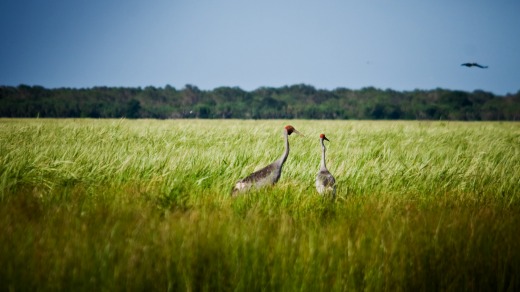
It's certainly not some flimsy timber construction you may find in Africa. It's been built to withstand the floods of the wet season and the Top End's potentially destructive cyclones and it hasn't been constructed just for twitchers. And if isolation heaped upon isolation appeals to you, it can be arranged for guests to be dropped at The Hide for a night and collected the next morning, with an emergency satellite phone provided by the lodge.
But for a neophyte twitcher like me you don't necessarily need a flash hide to get a true sense of the birdlife here, since it is all around you. On my first afternoon at Bamurru Plains, I'm not sure if I've been caught in the midst of a sequel of The Birds or a re-enactment of the bombing of Darwin. Hundreds of squawking corellas swarm above the lodge, headed for the termite-mound festooned floodplain where they feed on seeds. "The corellas are cheeky buggers," says Justin, one of our guides. "They love to creep up on the wallabies and bite them on their tails."
Of course the crocodiles are less known for their light-hearted traits, with those at Bamurru Plains no exception. On a four-wheel drive tour one afternoon to Mary Plains Billabong, we spot through binoculars the rotting carcass of a water buffalo, the victim, Justin informs our small group, of a lone croc resident in the dwindling dry-season waters.
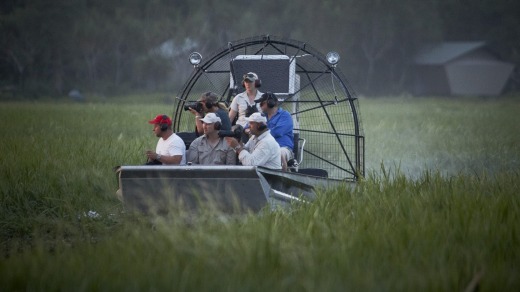
At Swim Creek Station, which apparently refers to a lone stream where it's safe for a dip, and home to between 5000 and 6000 head of introduced buffalo ultimately bound for export in Asia, such attacks by crocodiles are not welcomed by graziers. Yet the crocodiles aren't the only predator out here. "If you see the wallabies scattering across the floodplain in front of the camp, you know there's a dingo about."
As we head back to the camp for a gourmet communal dinner with the other guests – a collection of Australians, Dutch and Belgians – the fading light renders the grey termite mounds misshapen neglected gravestones. We're joined on our excursion by a family of wealthy Flemish are acutely aware that they're travelling in part of the world where "stations the size of Belgium" is no cliche but a palpable reality.
Swim Creek Station, after all, is 300-square-kilometre property, 100 square kilometres of which is comprised of water of some quantity, depending on the season. When we visit Bamurru Plains, the dry season is drawing to a close but there is still an enormous amount of water to behold on one section of Swim Creek, a short drive away. Even though the floodplain is drying up, the paperbark forests, with their exfoliating trees and branches and exposed roots revealing the level the water reached in the height of the wet, is still a watery wonderland.
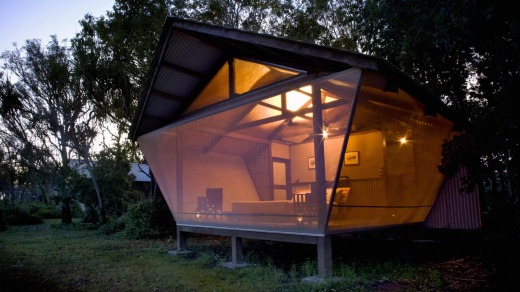
A haven for yet more birdlife, it's every bit as stunningly beautiful as anything I've experienced in Kakadu National Park itself, even though Swim Creek Station is a wholly private property cum accidental nature hotspot.
At breakfast on our last morning of our two-night, wish-it-was-three-night stay at Bamurru Plains, someone notices that the wallabies are retreating in large numbers from the flat, largely desolate floodplain. The cause of the commotion soon reveals itself: a lone dingo is spotted stalking the wallabies, darting from one side to another, trying to identify a member of its mob. All of the guests, and the guides, too, down their cutlery and pour out of the main lodge building to watch this spectacle of nature, which, on this occasion, the wallabies survive. It's another one of those goose-bump moments that has rendered this visit to this corner of the Top End utterly unforgettable.
www.travelnt.com
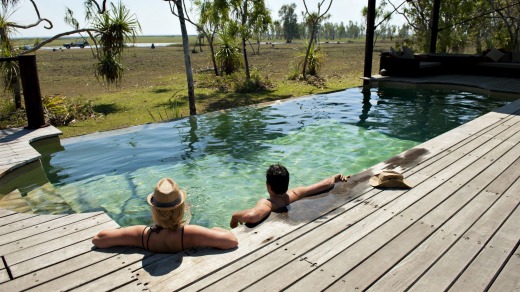
www.bamurruplains.com
Qantas, Virgin Australia and Jetstar all operate regular flights from Sydney and Melbourne. See www.qantas.com, www.virginaustralia.com and www.jetstar.com. Bamurru Plains is a three-hour drive from Darwin with a sizeable section of the private access road off the Arnhem Highway unsealed. Check with your rental car company as to whether you will need to hire a four-wheel drive vehicle. There is an airstrip on Swim Creek Station which received daily charter flights to and from Darwin. The flight, in a single-engine aircraft, takes just under half-an-hour.
Rates for Bamurru Plains start from $550 an adult, twin-share. Accommodation is in a safari-style bungalow with en suite with all meals and beverages from a select open bar included. Guided wilderness activities are not included but can be booked and paid for locally, subject to availability. Packages are available that include guide activities. The main season for wilderness safaris is between May and October with the lodge closed for the wet season between November and January.
